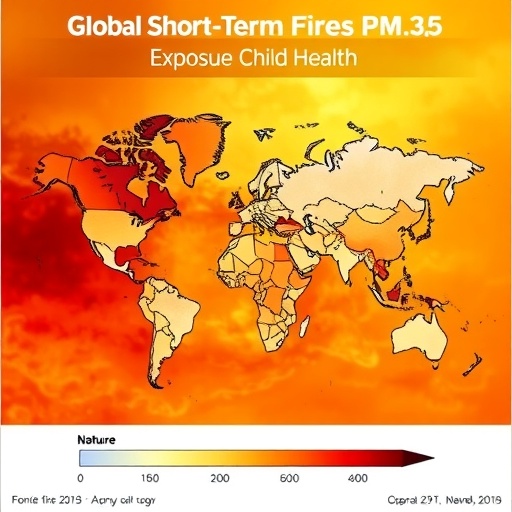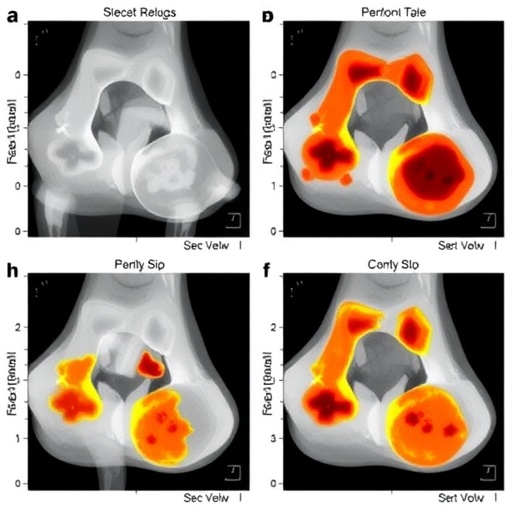In recent years, the alarming frequency and scale of landscape fires across the globe have captured the urgency of scientific investigation into their broader public health impacts. A groundbreaking study published in Nature Communications by Zhou et al. delves deeply into the short-term exposure to fine particulate matter, specifically PM₂.₅, originating from landscape fires, and its consequential toll on pediatric morbidity related to respiratory and other systemic causes. This research extends beyond localized case studies by integrating data spanning multiple countries and territories, thus offering a comprehensive global portrait that underscores the pervasive health threat posed by this environmental hazard.
Landscape fires, often driven by both natural phenomena and human activity, release a complex mixture of pollutants, with PM₂.₅ — particulate matter less than 2.5 micrometers in aerodynamic diameter — being a chief culprit in adverse health outcomes. The minuscule size of these particles allows them to penetrate deep into the respiratory tract, aggravating existing health conditions or initiating new disease pathways. Children, due to their developing respiratory systems and differing physiological responses compared to adults, are uniquely vulnerable to these airborne toxins. Zhou and colleagues’ study emphasizes the acute vulnerabilities in pediatric populations, connecting episodic exposures to spikes in healthcare visits for cause-specific illnesses.
The methodology of this study is notable for its sophistication and scale. Using satellite data coupled with ground-based air quality monitoring networks, the researchers meticulously quantified fire-sourced PM₂.₅ concentrations across diverse geographic regions. They then cross-referenced this environmental data with healthcare records detailing cause-specific morbidity in children, extracted from robust health surveillance systems. This integrative approach allowed the research team to tease apart the complex causative links between transient pollutant exposure events and subsequent health outcomes, a feat rarely achieved with such granularity at the global level.
What emerges from the data is a compelling narrative that short-term elevations in PM₂.₅ concentrations due to landscape fires are associated with statistically significant increases in childhood hospital admissions spanning respiratory diseases, including asthma and bronchitis, as well as other infections. The temporal alignment of exposure and morbidity spikes suggests a rapid pathophysiological response to inhaled fire-sourced particulate matter. Importantly, the study isolates the effect of PM₂.₅ from other confounding air pollutants, underscoring it as a primary driver of the observed health effects.
Moreover, the study illuminates disparities in health outcomes correlated with socioeconomic and geographic factors. Regions with limited healthcare infrastructure or high baseline pollution levels experienced disproportionate morbidity burdens during fire events. This finding points to a pressing need for targeted public health interventions and resource allocation, particularly in vulnerable communities that bear the brunt of combined environmental and social stressors. Furthermore, it highlights the intersectionality of environmental justice, climate change, and child health.
From a mechanistic perspective, the team explores potential biological pathways through which PM₂.₅ exacerbates pediatric morbidity. Fine particles can induce oxidative stress and inflammatory cascades in the respiratory epithelium, weakening pulmonary defenses and increasing susceptibility to infections. Additionally, systemic inflammation triggered by these particles may influence immune regulation, further complicating respiratory and systemic health conditions in children. The tantalizing glimpse into molecular pathways lays the groundwork for future therapeutic or preventive strategies.
Perhaps most striking is the global breadth of the analysis, which incorporates data from countries and territories with widely varying climates, fire regimes, and public health landscapes. This comprehensive approach lends robustness to the findings and suggests that the health risks associated with fire-sourced PM₂.₅ are universally relevant, transcending regional idiosyncrasies. The study thereby elevates landscape fires from a localized environmental concern to a pressing global pediatric health crisis requiring coordinated international attention.
The implications for public health policy and wildfire management are profound. By quantifying the health burden attributable to fire-related PM₂.₅ exposure, the study provides empirical evidence to support enhanced air quality monitoring during fire seasons and the development of early warning systems tailored to reduce children’s exposure. Additionally, it advocates for integrating air pollution considerations into landscape fire mitigation strategies, emphasizing the importance of preemptive measures such as controlled burns and rapid firefighting responses to limit pollutant dissemination.
The study’s innovative use of multi-national health data also highlights the future potential of leveraging big data and cross-sector collaborations in environmental health research. Combining satellite environmental monitoring with electronic health records creates a powerful framework for real-time assessment of pollution events and their health impacts. This paradigm holds promise for other pollutant-related health domains and could usher in a new era of precision public health interventions focused on vulnerable populations like children.
While the study robustly characterizes short-term exposures, it also raises pertinent questions about the longer-term health consequences of recurrent landscape fire events. The cumulative impacts of repeated PM₂.₅ exposure on child development and chronic disease trajectory remain an urgent area for future inquiry. Longitudinal cohort studies employing biomarkers of exposure and effect could elucidate these chronic effects, enabling the crafting of more comprehensive child health protection policies.
Another critical dimension pertains to the interaction of fire-sourced PM₂.₅ with other environmental stressors such as urban pollution and climate change-induced heatwaves. These compounding factors may synergistically worsen health outcomes, adding layers of complexity to public health responses. Zhou et al.’s work sets an essential precedent for examining these multifactorial influences in holistic studies that integrate air quality, meteorology, and social determinants of health.
Technological advancements in air monitoring and modeling further empower continuous refinement of the exposure-health outcome relationship. Emerging low-cost sensor networks and enhanced satellite capabilities promise to improve spatial and temporal resolution of PM₂.₅ measurements during fires. Coupling these innovations with machine learning approaches could facilitate predictive analytics that anticipate morbidity spikes, enabling proactive healthcare system preparedness and community education efforts.
Importantly, this study also brings attention to the role of climate change in escalating landscape fire incidence and severity. As global temperatures rise and precipitation patterns shift, fire seasons expand, increasing the frequency and magnitude of smoke exposure episodes. Thus, efforts to mitigate greenhouse gas emissions and adapt to changing fire dynamics are integral to protecting child health on a planetary scale. The research by Zhou and colleagues underscores the interconnectedness of environmental stewardship and pediatric well-being.
Public engagement and awareness are pivotal components in combating the health challenges posed by landscape fires. Effective communication strategies grounded in scientific evidence can empower caregivers and communities to minimize children’s exposure during fire events. This includes promoting indoor air purification, limiting outdoor activity during peak smoke episodes, and reinforcing community-level preparedness plans. The study’s compelling findings offer a basis for amplifying public health messaging that resonates with diverse audiences.
To sum up, this landmark multi-country investigation delivers compelling, data-driven insights into how short-term exposure to fire-sourced PM₂.₅ significantly elevates cause-specific morbidity in children. By advancing our understanding of the magnitude, mechanisms, and disparities of this risk factor, Zhou et al. provide a critical foundation for evolving public health strategies aimed at safeguarding young populations amidst escalating landscape fire challenges. Their work vividly illustrates that the intersection of environmental change and child health demands urgent, coordinated action to prevent avoidable illness and secure healthier futures globally.
Subject of Research: The impacts of short-term exposure to landscape fire-sourced PM₂.₅ on pediatric cause-specific morbidity across multiple countries and territories.
Article Title: Impact of global short-term landscape fire sourced PM₂.₅ exposure on child cause-specific morbidity: a study in multiple countries and territories.
Article References:
Zhou, S., Zhang, Y., Yang, Z. et al. Impact of global short-term landscape fire sourced PM₂.₅ exposure on child cause-specific morbidity: a study in multiple countries and territories. Nat Commun 16, 9347 (2025). https://doi.org/10.1038/s41467-025-64411-0
Image Credits: AI Generated
Tags: child health impactsenvironmental health hazardsepidemiological studies on air pollutionfine particulate matter health risksglobal fire PM2.5 exposureglobal health research on fire emissionslandscape fire pollutionlandscape fires and public healthpediatric respiratory morbidityrespiratory health in childrenshort-term air quality effectssystemic health effects of PM2.5






